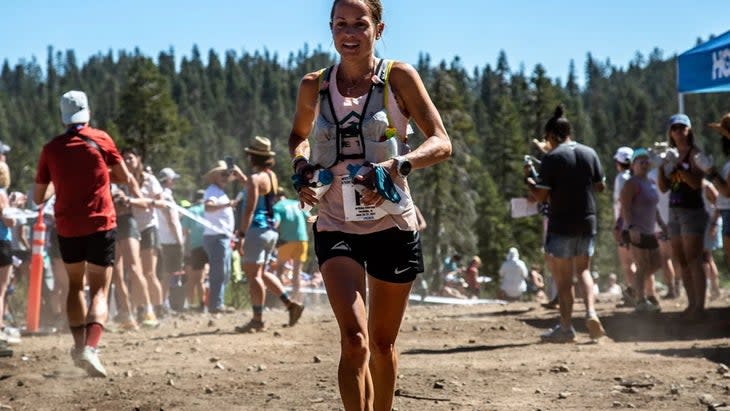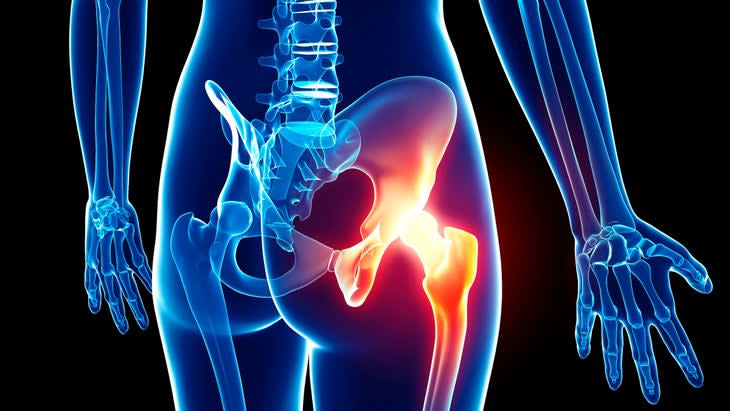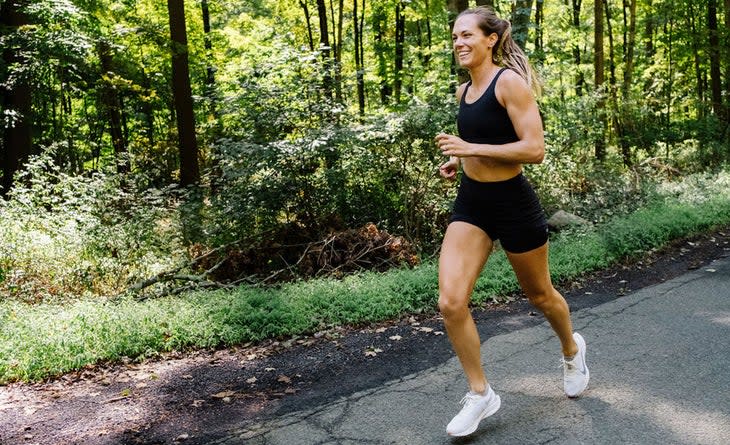Hip Joint Dysfunction in Runners: Causes, Solutions, and a Return to Pain-Free Movement
This article originally appeared on Trail Runner
All runners need strong, stable, and mobile hips. Hip strength dictates an athlete's ability to run, jump, twist, move faster, and more economically. But what happens when there's a problem within the joint itself?
One of the more common hip injuries among athletes is a labral tear, typically diagnosed via MR imaging or CT scan. Due to technological advances in MRI and arthroscopy, a 2009 study stated that "the prevalence of labral tears in patients with hip or groin pain has been reported to be 22-55 percent.”
The hip labrum is the hard ring of cartilage in the hip joint that provides cushioning and support for the head of the femur, and it can tear via acute injury or overuse.
Dr. Andrew Jimenez, Hip Preservation and Sports Medicine Surgeon at Yale University, states that, "This can occur in athletes who participate in sports that require high levels of repetition that place load on the hip. Other hip conditions like hip dysplasia or hip impingement [femoroacetabular impingement, FAI] can make a patient more susceptible to labral tears."
How Do You Know if You Have a Labral Tear?
The diagnosis of a tear is simple--with the right imaging and right specialists, that is--but distinguishing pain from this injury is certainly more opaque, as pain can range from deep glute pain, anterior or lateral hip pain, sacroiliac (SI) joint and lower back pain, even pain to the hamstring, knee, and psoas. To further the confusion, a large majority of labral tears reported on MRIs are completely asymptomatic, while a "normal MRI" often correlates with symptoms described above.
So it doesn't come as a surprise that we (Brittany Peterson, Anna Mae Flynn, and Mary Johnson) ran through vague hip pain for years, not understanding the extent of injury or the risk associated with our labral tears. Each of our journeys were different, but there was one common theme: the ups and downs with running were actually caused by an anatomical predisposition (or "impingement"), which resulted in a tear of the labrum. But we all had a solution and a path forward to pain-free running: labral repair and FAI surgery.
RELATED: A Trail Runner's Guide to Hip Pain
However, the process toward diagnosis wasn't straightforward. None of us had a clear diagnosis initially, and it often felt like something was missing in our journey to being healthy runners with sustainable training. Mitigation of symptoms was possible for a while as running performance oscillated. We spent years investing in physical therapy, heavy strength training, manual therapy, and biologics, including PRP and cortisone injections. Conservative measures helped us string together a few training blocks, but the joy of fitness was fleeting, as we always ended up with another injury related to our hips.
Over time, as our injury progressed, we no longer "just" experienced vague hip pain. Anna Mae noticed atrophy of the whole leg on the injured side. Mary had stress reactions in the sacrum, femur, and pubic bones. Brittany was experiencing nagging issues with her knee and hamstring.

The referred injuries come as no surprise. "Proximal stability leads to distal mobility. With a labral tear, you lose that suction in the joint that the labrum provides, which signals the brain to tighten everything around it to help stabilize the joint. So if we aren't stable at the hip, it's going to change how the rest of the leg performs," states Dr. Trish Ahrends, DPT, BSSPME, and also an ultrarunner and running coach who is recovering from her own FAI with labrum repair in 2023.
How Do You Know When Surgery Is Necessary?
Considering surgery was not an easy choice, but for us, it was necessary. The ongoing pain took over our lives and prohibited us from functioning at a normal level.
"Determining if someone is a good surgical candidate for hip arthroscopy involves a thorough evaluation. In general, active patients without evidence of osteoarthritis (wear and tear of the cartilage in the hip) have the best surgical outcomes," says Jimenez. "There is some literature to suggest that operating on labral tears earlier (within two years of symptoms) portends to a better outcome as well."
After getting answers that explain the nagging running dysfunction, committing to surgery and selecting your surgical team are the first steps toward the ability to return to functional running. The moment you have a surgical date, you can shift your focus to rehabilitation.
Dr. Marc Philippon, Orthopedic Surgeon and Managing Partner of the Steadman Clinic in Vail, Colorado, states: "Rehabilitation is key to returning to previous level of activities and achieving long term goals so patients should be prepared for the extensive work and time it requires for the best possible outcome." This mindset on rehabilitation is essential throughout the entire recovery phase, even before you have surgery.
RELATED: Anna Mae Flynn's Advice For Home Training
‘Pre-Habilitation’ from Surgery
This early phase in your recovery process could be called the "prehabilitation phase." It is important to start the strengthening process as early as you can in order to go into surgery at the highest level of conditioning possible. Depending on your surgical team, you may already be assigned to a physical therapist or an athletic trainer to provide you with guidance on what exercises you should be doing during this phase (knowing that you still have an anatomical limitation and therefore, will still often struggle to complete these exercises in the most effective way with full range of motion and proper glute activation).
Following surgery, you will see many different post-operative protocols, depending on your surgical team. According to Ahrends, there is one critical feature to this protocol.
"One universal concept that I believe is 100 percent important is early return to movement," says Ahrends. According to her, in the acute phase of recovery, post-operatively the tissues are being remodeled. "We need the tissue to know how to lay down appropriately. If we don’t show it, with some type of movement--like stationary biking with no resistance, a CPM [Continual Passive Motion] machine, hip circles and range of motion done passively, light isometrics--then the tissue will lay down disorganized and not as strong."
To balance this concept of early return to movement, one must also consider properties of tissue healing and ensure their return to activity is not too aggressive. Generally following surgery, there will be a period of time that requires non-weight-bearing or limited weight bearing through the surgical side. This can be two to six weeks after surgery, depending on the specific surgeon's protocol.
Along with the limited weight bearing, one likely would also have range of motion restrictions to allow the surgical site and impacted structures and tissues adequate time to heal. The hip is dislocated during surgery, so the importance of sticking to this protocol is critical to ensure the healing joint literally stays in place.

'Patience Is Key'
Despite these restrictions, your rehabilitation process is not deterred. You now have a repaired labrum that was tightened and secured in its proper anatomical position, and any bony deformities around the joint were removed, which now promotes the ability to progress toward full range of motion at the hip. With this proper alignment and full range of motion, the goal now is to work on relearning proper motor planning and activation patterns that maximize glute recruitment, activation, and strength.
"You are going to have a lot of old patterns to re-write which takes a lot of time. You have to develop new motor patterns, and patience is key," states Ahrends, when discussing the rehabilitative process post-operatively.
This is what the immediate months following surgery would look like. The primary goals are to progress back to a full range of motion, increase strength, and relearn activation patterns. This means significant time spent on rote exercises simply relearning how to move your own body and pay attention to hints that would indicate you are returning to patterns of compensation.
Dr. Jimenez says that "the key to a successful outcome is multifactorial but, in my opinion, open communication between the surgeon and the athlete is crucial." Each case is different and needs to be individualized to that person's specific needs. This is where your surgical team and their associated rehabilitation team are critical to success.
Recovering from a surgery like this is a long process, and many factors--duration of symptoms, amount of deformity needing correction, expansiveness of associated damage to and around the joint, for example--need to be taken into consideration. The athlete should have a team of professionals, including the surgical team, associated physical therapist, and, ideally, an athletic trainer to assist them in maximizing their progress in order to promote the best possible outcome.
Further out from surgery, an athlete may also benefit from a strength coach or more formalized strength training to continue to progress the strength and function of the hip as the athlete returns to a more formalized training routine.

Returning to the Run
Transitioning from rehabilitation to a "return to sport," which, in our case was high-level running, is typically a 12-week program, depending on the surgeon's protocol. "Being an elite athlete typically means higher levels of strength and endurance, higher levels of body awareness, and a drive to work hard. These attributes can help [the athlete] achieve a higher outcome," says Dr. Philippon.
Most surgical teams provide a protocol that outlines a gradual progression in running loading. In the first few weeks, running is limited to short run-walk intervals and, over time, the running intervals will increase. In the first two months in the "return to run" process, generally the running duration per activity doesn't exceed 30 to 60 minutes. This process is similar for runners at all levels; it's just the individual’s time commitment to PT and strength work that really differentiates the progress.
RELATED: A 2-Minute Exercise-Band Routine For Strong Hips
Strength training and physical therapy are critical for the transition back into running. The hip joint is relearning how to absorb the running forces. Glute endurance and core strength is the fundamental pillar upon which all run training builds. You may be done with your formalized physical therapy after the initial three months post-op, but expect to increase your loading in strength to prepare for the increase in loading with running. The hip takes a lot of the stress when running, so you want to make sure the muscles and tendons are absorbing the majority of the impact, not the joint.
In a case study in 2007, co-written by Philippon, involving 45 elite athletes who underwent FAI, athletes who continued to do PT and strength training were able to return to running more quickly and healthily ... "based on clinical observation, that this, in addition to an early emphasis on passive hip motion (particularly internal rotation) reduces the incidence of adhesion formation. Active hip flexion was limited for four weeks, based on clinical observation, to minimize the risk of hip flexor tendonitis. (93 percent) returned to professional sport following hip arthroscopy" Philippon, M., Schenker, M., Briggs, K., & Kuppersmith, D. (2007).

The Bottom Line
Progress isn't linear. It's normal to continue to experience symptoms in and around the hip as you reach each new level of recovery. You may experience tightness in your hip flexor, adductor soreness, or tender spots lower down the chain as your body is relearning how to move with a full range of motion with its newly functional hip joint and repaired labrum. Stay connected with your surgeon's rehabilitation team during this process. Dr Philippon says,"Patients should seek an experienced hip arthroscopy surgeon. Patients should not be afraid to ask questions about the number of surgeries performed each year, surgical outcomes, rehabilitation protocols, and follow-up care."
As you return to running, it’s important not to get ahead of yourself. Lean into the daily work just as you were in the months pre- and post-op. You'd be wise to listen to the cues that your body is telling you. Strength training takes precedence over running. What this means is, if you only have time for one or the other, choose strength work.
Being diligent about the "little things" outside of running will set you up for success with the running progression.
Give yourself permission to slow down, focus on form, and the biomechanics of running.
Lean on "your team" for support during this time.
Consistency is key, and in the months following the "return to sport" period you may be able to phase in speed work and build your longer runs.
Brick by brick you will get back to top performance. Be kind to yourself as you rebuild your foundation, knowing that depending on the years you've been running on improper biomechanics and a compromised hip it could take longer than prescribed to work back to 100 percent. The bottom line is that everyone progresses differently, but patience, persistence, and a lot of hard work can and will pay off.
For exclusive access to all of our fitness, gear, adventure, and travel stories, plus discounts on trips, events, and gear, sign up for Outside+ today.

